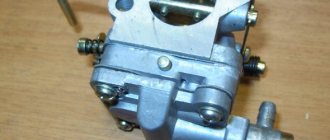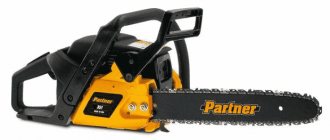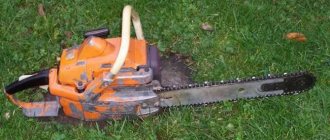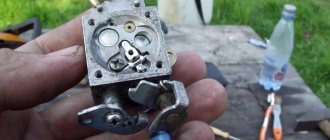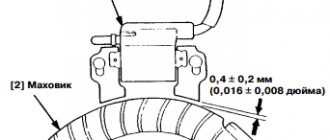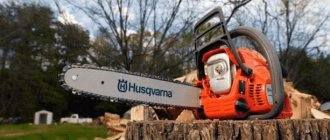A chainsaw is needed in construction, gardening, and landscaping - its presence greatly simplifies the performance of a number of wood processing tasks. The main component of this tool is the engine, the operation of which largely depends on the condition and settings of the carburetor. This is where the fuel mixture is prepared. This means that if the saw does not start, stalls, or does not provide the required power, it is likely that the reason for this is improper operation of the carburetor. Fortunately, in many cases you can deal with this on your own. Only for this you need to know and understand the structure and operating principle of this unit and, of course, the chainsaw itself.
- 2 Why is primary adjustment needed?
- 3 How to recognize carburetor failures?
- 4 Do-it-yourself disassembly: nothing complicated
4.1 Disassembling the chainsaw carburetor in the photo
How does a chainsaw carburetor work?
The main purpose of a carburetor is to mix fuel with air in the required proportions. If the latter are violated, this almost instantly affects the operation of the engine.
Chainsaw carburetor Stihl MS 181 C BE
Chainsaw carburetors may differ in design. However, their basic elements and operating principle remain approximately the same.
Carburetor design:
- The basis
This is a wind tunnel, across which there is an air damper - with its help the intensity of the air supply is regulated.
- Diffuser
This part is where the base tube narrows - here the air flow speed increases, i.e. air is always supplied to the carburetor under some pressure.
- Spray
In this area, the fuel comes into contact with the air flow. Fuel enters the atomizer from the float chamber through a nozzle (dispenser).
- Float chamber
This is a container that allows you to keep the fuel mixture in a stable state.
Chainsaw carburetor design diagram
A chainsaw carburetor works according to the following principle:
- when the engine starts, the main damper opens and a stream of air is supplied into the air channel at a certain speed;
- the speed of the air flow, as well as the level of the float in the chamber, are regulated by the position of the damper, namely due to the difference in pressure in the float chamber and the air channel;
- fuel from the float chamber is sucked into the nozzle, and from there into the diffuser;
- passing through the diffuser, the air captures the fuel entering there;
- the resulting mixture is fed into the cylinder cavities through the intake channels.
The principle of operation of a chainsaw carburetor
The pressure in the float chamber is approximately equal to atmospheric pressure, but a vacuum occurs in the air channels of the carburetor when the chainsaw engine starts. Opening the damper increases the air supply intensity. As a result, more fuel enters the carburetor, and the number of engine revolutions increases.
Features of washing in an ultrasonic bath
If you are wondering how to flush a chainsaw carburetor without disassembling it, then there is only one answer - nothing. An ultrasonic bath is also useless in this case, since during the cleaning process it is necessary to ensure the free removal of contaminants from the channels. If the carburetor is not disassembled, then these contaminants simply will have nowhere to go, and the result of such cleaning will simply be useless.
Some owners of gas-powered tools are looking for various flushing fluids and additives to the fuel mixture, hoping for their effectiveness. All these preparations and concentrates are simply useless, and if you really want to perform highly effective carburetor cleaning, then you should use a special ultrasonic bath. Even if your neighbor has convinced you of the effectiveness of such concentrates, then imagine the picture when all the contaminants enter the cylinder. Naturally, this will not lead to anything good, and as a result. Soon you will need to disassemble and repair or replace the internal combustion engine.
Ultrasound channel cleaning is the most effective, but even taking this factor into account, it is not possible to talk about complete restoration. It all depends on the extent of the clogging of the mechanism.
In addition, you must thoroughly know how to perform this procedure correctly. In particular, it is necessary to calculate the rinsing time as well as the temperature. The principle of washing a chainsaw carburetor in an ultrasonic bath is as follows:
- Remove the carburetor from the chainsaw and disassemble it
- It is necessary to disassemble the carburetor in order to ensure deeper penetration of the cleaning fluid into the channels
- The container fits the carburetor, except for small parts and rubber membranes
- You need to pour a special Ultra Red liquid into the container, which mixes with water
- Turn on the installation for the appropriate period of time 10-15 minutes
After completing the procedure, you will need to blow out the channels with compressed air, but carefully. After this, evaluate the quality of the flushing, and only after that assemble the mechanism.
Why is primary adjustment needed?
During the first hours of operation, the 2-stroke chainsaw engine requires running-in, on which the quality of its further operation depends. During the running-in process, the carburetor is initially adjusted - the optimal parameters for preparing and supplying the fuel mixture are established.
Initial running-in of the chainsaw: working with thin material
Most modern chainsaws are sold adjusted. However, it doesn’t hurt to check the quality of the factory settings - in the end, it’s you who will have to work with the tool.
When starting up for the first time, the chainsaw should operate in a gentle mode. Therefore, for several hours after start, it is recommended not to overload the engine and cut only small branches and trunks up to 10 cm thick.
Simple rules will help you insure against malfunctions of the chainsaw carburetor:
- Always mix gasoline and oil according to the manufacturer's instructions.
Proportions of the fuel mixture for a chainsaw engine - Do not prepare the fuel mixture in advance - the properties of gasoline and oil in a mixed state are lost over time. The exception is fuel for intensively used tools, however, even here the norm should not exceed approximately a week.
- Use oil designed for your chainsaw engine. A fuel mixture with a non-standard composition will seriously and permanently disable it.
- When preparing the fuel mixture, take into account the influence of climatic conditions on its components.
The chainsaw must start correctly, ensure a stable rotation speed of the sprocket and a smooth increase/decrease in power. There should be no extraneous knocks, pops or noises when the engine is running.
Professional hand chainsaw at work
The main thing during the initial running-in of the tool is to ensure that the fuel consumption corresponds to the power used, i.e. in practice, the saw should not go out, “sneeze”, smoke or run jerkily.
What type of carburetor is used in modern chainsaws
All modern chainsaws use membrane-type carburetors. They were developed by German designers of the world's leading chainsaw manufacturer Stihl in the mid-50s of the last century and revolutionized the design of chainsaws.
Before this, float carburetors were used, which could only work when the chainsaw was in a vertical position or tilted no more than 45-50 degrees. New membrane devices made it possible to operate a chainsaw even in an upside-down position.
Diaphragm type carburetor from different angles.
Carburetor tuning: main points
Reassembly of the carburetor is carried out only after complete cleaning, drying and blowing with compressed air. However, do not forget that some gaskets and seals, even if there is no damage, must be replaced.
You can begin adjusting the carburetor if it is correctly troubleshooted, of high quality assembly and flawless re-installation on the engine.
Adjustment screwdriver
Principles of carburetor tuning:
- screws H and L adjust the ratio of air and fuel mixture, i.e. throttle position. Tightening the screws clockwise leads to a lean mixture and the engine switches to low speeds. When unscrewing (counterclockwise), the mixture becomes richer and the engine speed increases;
- screw T is responsible for adjusting the idle speed: turning it clockwise increases their number, counterclockwise - decreases it;
- The screws are adjusted in LHT order.
Chainsaw carburetor calibration
The general adjustment algorithm looks something like this:
- Initially, the highest idle speed is found by turning screw L and then returning ¼ turn counterclockwise. If the chain rotates at idle, turn screw T in the same direction until it stops completely.
- With the engine warm and running at full speed, turn screw H ¼ turn to the left, then let the engine run for 10 seconds and check the maximum speed using a tachometer. It must correspond to the number indicated in the instrument passport.
- After calibration with screws L and H, using screw T, the idle speed is adjusted. If everything is done correctly, the engine will operate evenly in all its positions.
Reminders for calibrating the carburetor on the chainsaw body
Upon completion of the adjustment, all that remains is to reinstall the chainsaw cover with the insulating gasket, after which you can begin the main work. If the settings are correct, the chainsaw engine will receive the optimal fuel mixture. This will ensure its normal efficiency, as well as overall comfort and safety of working with the tool.
User questions about chainsaws
The Husqvarna chainsaw started only on choke and then stalled. I bought a new Chinese carburetor, it looked exactly the same, it started idling smoothly and started without any suction. You start sawing and after 2 seconds it stalls. If you re-gear it, it still cuts for a little while, but then it still doesn’t hold high speeds. What's the matter?
First, check the fuel filter. If OK, back out the low speed screw (L) until it starts to pick up speed normally. Since X.X will increase, reduce it with the bolt (T) that is on top.
Chainsaw McCULLOCH MAC930 CC30 KW1.2 tire 35 cm, assembled in Italy in the 90s. Piston, seals are ideal. Doesn't hold idle speed or doesn't pick up speed when you try to accelerate it, it feels like it's choking on gasoline. Gasoline is pouring from the exhaust. What is the problem and how to fix it?
According to the symptoms described, gasoline is not flowing well, probably because the diaphragm has dried out due to long inactivity. You can fill the saw with gasoline, pump it manually and leave it for a while. From gasoline, all the rubber bands should get wet and start working. If that doesn’t help, then you can pick up a carburetor from some modern Chinese saw of similar cubic capacity (for example, from Shtil). After replacement, adjust the joint with the cylinder.
If I fill a Husqvarna chainsaw with Stihl oil or any other branded oil, should I follow the proportions of 1:25 as indicated in the instructions?
If branded oil for two-stroke engines is poured, then it does not matter which manufacturer it is from. High-quality fuels and lubricants from well-known brands are interchangeable, and recommendations are only a marketing ploy. You can safely fill a Stihl chainsaw with Husqvarna oil and vice versa, observing the proportions as for branded fuels and lubricants.
Why does a chainsaw cut crookedly, that is, it moves to the side?
The tire misaligned due to uneven wear. Don't forget to turn it over when working! If the tire is already worn unevenly, only replacement will help.
Why does the Taiga 245 chainsaw only work on suction and the carburetor cannot be adjusted?
Possible options: the carburetor diaphragm is broken, the gasket between the cylinder and the crankcase, the carburetor and the cylinder is not sealed, the crankshaft seals are leaking. In Taiga 245, when air is sucked into the crankcase from the outside, the functionality of the fuel pump built into the carburetor is disrupted due to the lack of vacuum. In this case, the saw will not work. The suction closes the air supply to the carburetor. This confirms the lack of tightness in the places indicated above.
Step-by-step disassembly instructions
The carburetor design of models of different brands is almost the same, so let’s take the Partner chainsaw as an example. We carefully remove each element and place it in order to make it easier to assemble later.
Recent Entries
Lilac perennials that are beautiful, compact and do not crowd out other plants Why when buying seedlings you should not take the sellers’ word for it and how to determine the age of the plant using 3 signs Tomato seedlings have turned purple or whitish: why the color has changed and how to save the plants
Carburetors of chainsaws from different manufacturers, if they differ, are not fundamentally different
The top cover is removed by unscrewing three bolts. Following it is foam rubber, an integral part of the air filter.
The arrows indicate the bolts that must be unscrewed to remove the cover.
Then we remove the fuel hose, followed by the drive rod.
The upper arrow points to the fuel hose, the lower arrow to the drive rod
Next, remove the cable end.
The arrow shows the cable tip that needs to be removed
We pull off the gasoline hose from the fitting on the left.
We also carefully remove the gasoline hose, which the arrow points to.
We finally disconnect the carburetor, it is ready for adjustment. Its mechanism is quite complex, therefore, if further disassembly of the carburetor is required, you should remove the elements very carefully - they are small, so they can get lost.
The carburetor consists of many small parts, which should be laid out in order when disassembling
